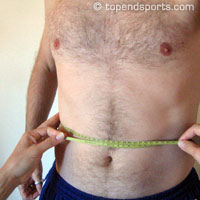The waist to hip ratio is the ratio of waist circumference to the hip circumference, a simple calculation of the measurements of the waist girth divided by the hip girth. This test has been shown to be related to the risk of coronary heart disease. The basis of this measure as a coronary disease risk factor is the assumption is that fat stored around the waist poses a greater risk to health than fat stored elsewhere in the body.
purpose: to determine the ratio of waist circumference to the hip circumference, as this has been shown to be related to the risk of coronary heart disease. 
equipment required: tape measure
procedure: A simple calculation of the measurements of the waist girth divided by the hip girth. Waist to Hip Ratio (WHR) = Gw / Gh, where Gw = waist girth, Gh = hip girth. It does not matter which units of measurement you use, as long as it is the same for each measure.
scoring: The table below gives general guidelines for acceptable levels for hip to waist ratio. Acceptable values are excellent and good. You can use any units for the measurements (e.g. cm or inches), as it is only the ratio that is important.
| male | female | |
|---|---|---|
| extreme | > 1.00 | > 0.90 |
| high | 0.95 - 1.00 | 0.85 - 0.90 |
| average | 0.90 - 0.95 | 0.80 - 0.85 |
| good | 0.85 - 0.90 | 0.75 - 0.80 |
| excellent | < 0.85 | < 0.75 |
target population: This measure is often used to determine the coronary artery disease risk factor associated with obesity.
advantages: the WHR is a simple measure that can be taken at home by anyone to monitor their own body composition levels.
Similar Tests
- General procedures for girth measurements, plus waist girth and hip girth procedure
- Adiposity Index — another measure of body composition using the hip circumference and height
- Waist to Height Ratio — a simple body composition measure
Related Pages
- Other body composition tests and anthropometrical tests
- About measuring body composition
- Using girth measures to calculate percent body fat
- Using MyoTape for girth measurement.


 Current Events
Current Events